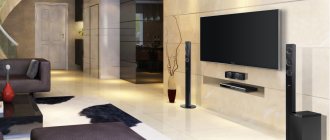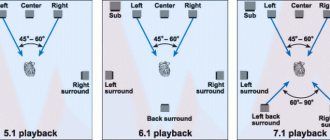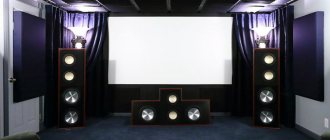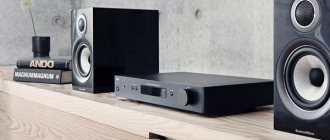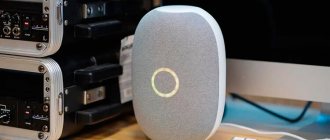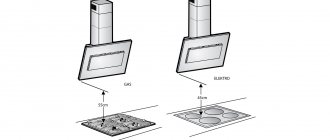Content:
- 1 What is this?
- 2 Pros of surround sound
- 3 How to connect?
- 4 Connectors
- 5 Sequence 5.1 Video setup
- 5.2 Limits 5.2.1 Brightness
- 5.2.2 Contrast
- 5.2.3 Color palette
There is a TV in every home. It is no secret that modern technology has a wide range of functions, so the user often has questions about connecting additional devices or options.
A common question: how to connect a home theater to a TV. This article will help solve this problem.
What is this?
Before analyzing the question of how to connect a home theater to a Samsung or other brand TV, it is worth taking a closer look at the configuration and features of such equipment. Such cinemas are a collection of equipment for watching videos. The key feature of the technology is high-quality sound accompaniment of the picture transmitted to the screen.
In other words, home cinema is a complex system that includes:
- TV;
- columns;
- tuner for receiving signals;
- video recorder;
- disc player.
The system also provides wires and corresponding connectors for connecting additional options or functions to the home theater and TV.
Another feature of the cinema is its ability to transmit a standard television signal. This allows you to add a line of TV channels and adjust the sound so that the image on the screen seems more voluminous.
Features and nuances of connecting a home theater to a TV
The standard set of home theaters includes the following equipment and components:
- Signal source provided by DVD or Blu-ray player
- 5 speakers, where 2 are front, 2 are rear and 1 is center
- Subwoofer
- Connecting wires
- Remote control
Manufacturers of home theaters advise connecting them to TVs of the same model, which will guarantee better compatibility during operation and better signal transmission.
The benefits of surround sound
The main advantage of such equipment is 5.1 surround sound. To understand what its advantage is, it is necessary to understand this issue in more detail. It’s worth starting with the standard audio format – mono. In this case, the signal is distributed from the interlocutor who is sitting next to the owner of the device.
In this case, the position of the interlocutor, as well as the sound wave, does not change. If the person receiving the sound gets up and walks around the room, he will still only hear the signal from one point. To transmit this audio format, one speaker or receiver is enough.
A more complex format involves the use of two speakers, which will allow you to determine where the sound is located. The disadvantage of this format is that the person needs to remain in place. Additionally, it is worth noting that if the signal is not on the right or left, but in front or behind, the speaker will not be able to transmit it.
It's worth understanding how to connect a home theater to your LFG TV. The standard system contains several elements:
- Receiver. Responsible for processing signals received from the TV to reproduce pictures and sound. The receiver also determines where the image will go and where the sound will go.
- Audio system. The standard set includes up to 5 speakers and a subwoofer. This configuration allows for the transmission of even the lowest frequency signals.
- Sound source. A fairly common option is a DVD player.
The latter is added to improve the transmission of low frequencies. Although this is practically unnecessary. The diameter of the speaker depends on the frequency of the sound. And the lower the indicator, the larger the column required. Interestingly, at the lowest frequencies, a person’s orientation in space works worse, and he has difficulty determining where the sound is coming from.
How to connect?
So, we managed to figure out the contents and features of the home theater. Now it’s worth understanding how to connect your home theater to your TV without errors and in a short time. A complicated model is a cinema, which includes three main blocks:
- AV receiver.
- Audio system.
- player or turntable.
Sometimes the connection requires wires. In this case, there is a high probability that the user will quickly mix up the cables, get tired and abandon this task altogether.
Often, to simplify the task, an assembly manual in several language formats is included with the equipment. With its help, the user will understand how to connect a home theater to a Samsung TV or a device from another manufacturer.
Sometimes there may be no guidance. Then you should carefully read the article and note the main points that can help in the process.
How to connect the receiver
There are different models of home theaters that can be equipped with various elements. Quite often, a receiver is included in the kit, which serves as a distribution and amplification of the sound signal. To connect your home theater to your TV, you need to start by connecting the receiver to it. Then the acoustic system is connected to the receiver and placed around the room.
Modern TVs are equipped with several connectors for connecting a variety of devices to them. Look at what outputs your TV screen has on the back. Ideally, you need to understand what types of connectors are present before purchasing a home theater. Most likely, you will have to purchase the necessary connecting cords, since they are not included in the kit.
Connecting the TV to the receiver is quite simple. This can be done through the following channels:
- HDMI;
- SCART;
- S-Video;
- Y Pb Pr;
- analog connection.
The most advanced modern communication channel at the moment is the HDMI format. It provides high quality video and audio transmission. It is better to connect the TV through a home theater through this interface. An HDMI cable is required for connection. Switching is done to the corresponding input labeled IN on the TV and OUT on the receiver.
In the case where the TV does not have such a channel, the connection can be made through the component port (Y Pb Pr). This signal transmission format is also high quality. Find Component video on the panel. You will see three connectors of different colors. The cable plugs have three tips of similar shades, which connect to sockets of the same color.
Imported equipment, such as Samsung, LG, Sony, etc., are often equipped with SCART connectors. See if your TV has a similar port. This is also a high quality standard. If there are no other interfaces, you can connect to the TV using a SCART cable.
Older models of television equipment may not have the connectors described above. Then, you will have to use those that are available. The S-Video format can be called morally outdated. This is a low quality channel that transmits low resolution images. However, if there are no more modern interfaces, you will have to use it. Connect your devices using an S-Video cable to the IN (on the TV) and OUT (on the receiver) jacks.
The oldest and most primitive signal transmission format is Video. The connection here is made using wires, which are popularly known as “tulips”. Just as in other cases, in order to make a connection, find the corresponding inscription on the panel (Video) and insert the plug into the connector.
There are also different ways to output sound from a TV to a home theater. The audio signal can be transmitted through several connecting cables. Their choice depends on the TV model.
To transmit a high-quality audio signal, a fiber-optic wire is used. To connect devices in this way, your TV must have a digital optical connector. Find the Optical inscription on the panel and insert the connector into the appropriate port.
If this output is not available, you can connect TV audio using a coaxial wire. Check if your devices have an interface called Coaxial. Connect the wire plugs to the sockets of this format. A popular way to transmit sound is to use PCA connectors (tulips). These connecting wires are found in almost all home theater speaker kits. If your TV monitor does not have other ports, use the simplest one.
Connectors
First, you need to note what types of connectors are available that the owner of the equipment needs to connect a home theater to a Samsung TV or a model of another brand. Main types of connectors:
- HDMI;
- RGB;
- SCART;
- S-video.
Manufacturers also sometimes provide analog connectors, which are also called “bells” or “tulips”. A budget option for connecting a TV receiver.
When choosing a home theater, preference should be given to HDMI connectors, which will allow you to get high-quality picture and sound.
As for the coaxial cable, it is suitable if it is not possible to purchase equipment with the first two connector options. It is noteworthy that some cables are responsible for transmitting exclusively the video signal; the sound will be transmitted by the home theater speaker system.
One of these cables is component cables. Its design includes three plugs, each with its own shade.
During the cable celebration, it is possible to obtain a clear image that is no different from the analogue one. If one of the devices has the ability to connect a SCARD cable, then you should use this connection option. But it is worth considering that sound will not be output to the TV.
Last cable type: S-Video. Quite an old cable format that is becoming less popular on the market. Such wires are capable of transmitting a low-quality analog signal and nothing more. However, cables are still popular among some users.
Interestingly, some models include cables. Then the user will not need to independently select and buy wires.
Cables and wires
Connecting cables and wires is the second most difficult part of a home theater installation, after speaker placement. They can be an aesthetic nightmare and a dangerous foot trap, but you can't do without them unless, of course, the speakers are used only as decoration.
Wireless rear speakers will eliminate the need for wires running from one end of the room to the other, but they will still need power, so wires running from the control unit to the speakers in the back of the room are inevitable.
The home theater is connected to a computer via the LAN port on the rear panel or the built-in wireless module. In addition, access to the home network will allow you to replace the device software, access online content, etc.
Home theaters, Blu-Ray/CD/DVD players, video recorders and other home audio and video equipment can all be located anywhere as long as the cables are long enough. It's better to use HDMI wherever possible to get rid of the chaotic tangle of wires that makes finding the right connection a nightmare.
Connecting a home theater to a TV or monitor is done using just such a cable. In this case, you must select the appropriate image source on the device itself. A cinema projector is connected in the same way.
The best option is when the home theater cable is laid under the floor or hidden by a carpet. Otherwise, it would be a good idea to purchase fasteners for laying along the baseboards at the bottom of the wall, where they will not interfere so much.
Make sure that the audio outputs and inputs are connected to the same color. Some systems come with colored wires for each speaker, in which case the speaker wiring diagram specified in the manufacturer's instructions must be followed.
Subsequence
Not everyone knows how to connect a home theater. Usually they trust the manual, which spells out the main points. If instructions are not provided in the kit, you can turn to the diagram for reliable connection of the home theater to the TV for help. It is important to note that before carrying out work, you should disconnect the equipment from the electricity.
To connect the system to a TV device, you will need:
- First of all, inspect the TV and cinema to make sure there are identical inputs and outputs. This is the only way to subsequently select the necessary wires to connect the devices.
- Carefully study the home theater connection diagram drawn up by the manufacturer, if it is provided for in the instructions. Otherwise, perform the following sequence of actions.
- Transfer audio and video signals from the speakers to the screen. The HDMI connector is most often used, but if desired, there is the option to use other cable models. To output sound and pictures, you must first check if the required output is on the receiver, and the input is on the panel of the television device. When purchasing HDMI PC models, there is no need to save money and give preference to Chinese models. They can ruin the quality of video or sound, and sometimes crash during operation.
- Connect the connectors of different systems with wires and check the functionality of the equipment. Before this, it is recommended to assign the port that was used as the image transmission source. It is noteworthy that if one of the devices does not have an HDMI connector, then you can use SCARD. This option will help maintain the quality of the video stream transmitted by the device. To connect, you will need to connect the plugs to the appropriate output.
- Connect the speakers to an available receiver. Typically, the necessary inscriptions for connecting a cinema to a TV are placed on the back panel of the device. During the process, it is worth looking at the color coding of the cables, computer and holes. The shades must match.
- Install speakers. To do this, you need to find a suitable place where you can place a cinema in the complex. Typically, the front speakers are placed on the sides of the TV, the rear speakers are placed in the rear, and the center speaker is installed slightly higher or lower relative to the screen.
- Install the TV. It can be installed on a cabinet, table or stand, or mounted on a wall.
- Plug in the devices. After installation and startup of the equipment, you need to check the functionality of the system.
If the image quality is high and the sound does not require any modifications, everything was done correctly. So, how to connect a home theater to a Sony TV? Everything is quite simple if you follow the steps. Many people are interested in how to connect a home theater to a Phillips TV.
Video setup
The second step in how to connect a home theater to a Panasonic TV, which you need to pay attention to in order to enjoy watching movies or other content, is setting up the home theater and other video parameters. Before carrying out the process, it is worth setting a restriction on the ability to set automatic parameters. This is necessary to achieve optimal picture quality.
To understand how to connect a home theater to an LGI TV, you need to understand the adjustment:
- screen borders;
- brightness and contrast;
- color palette;
- clarity.
It’s worth taking a closer look at how to configure each of the parameters to connect your home theater to a TV device.
Borders
The corners of the image contain arrows, the sharp ends of which should reach the edges of the display. If you choose the wrong image, its clarity may decrease. In some cases, the screen cuts off the picture, which also interferes with full viewing.
The main sections of the menu that are recommended to be taken into account if you want to connect a home theater to a Samsung TV:
- Overscan;
- Full Pixel;
- Original.
Adjusting the settings will help align the image on the screen and make the picture clearer and more visually visible. Instructions on how to connect a TV to a home theater and set up the system will be discussed in more detail. It is worth studying each stage carefully.
Brightness
If you correctly approach connecting your home theater to your TV, then there is an option to see all the shades of the image by adjusting the brightness. If the brightness is low, then the picture will merge if there are dark areas in it. If the brightness is too bright, the image will merge, on the contrary, in the bright areas. It is important to take this into account so that the main question then disappears: how to connect a home theater to a Philips TV.
Contrast
Standard setting for selecting optimal image visibility by changing the scale. If the contrast is too high or too low, the user will not be able to see some areas of the image.
Color palette
Setting this parameter, if you answer in detail the question of how to connect a cinema to a TV, requires compliance with the golden mean. It is important that the image has both light and dark areas. If you plan to install a natural color palette, it is recommended to slightly reduce the color saturation.
It is recommended to ensure that the white color does not change while adjusting the parameters. To do this, it’s worth looking at what the color strip looks like, which shows almost transparent squares. This will help speed up the process and understand how to connect a home theater to a Philips TV.
Definition
You can check the level of screen clarity at the place where two lines intersect. If they have no shadows or halos, they are done correctly. Clarity settings are rarely requested.
Sound settings
Once you can figure out the picture, you can start working on the sound. The optimal parameters in this case will be the sections of the receiver’s menu. Changes are made mainly using the remote control. Sequencing:
- Selecting the Small mode when connecting small speakers and the Large mode if you plan to buy large speakers for a large system.
- Select Normal mode to set up a center-mounted speaker. Then you will be able to achieve excellent sound from the speaker.
- Installing a speaker in the center of the hall. This need arises if it was not possible to install the speakers in a circle.
The above points are written for those who are thinking about how to connect a home theater to an LG TV and other models. Afterwards all you have to do is turn on the filter. In this case, you can adjust the position of acoustic devices, thus changing the music or sound field.
Setting up acoustics
The last stage, which involves adjusting the acoustics for the home theater for the TV. Each has its own abbreviation or number. To adjust the acoustics in the house, you need to place the speakers at an equal distance from the visitor when connected.
If a home theater is equipped with a subwoofer, then no one will have any questions about connecting it. If you use manual configuration, the process will be quite complicated, so if possible, it is better to entrust this task to specialists.
Interestingly, most modern receivers provide automatic updating or replacement of acoustics. All the owner will need to do is:
- connect the microphone to the main element of the system - the receiver;
- install it in a place where the viewer will be;
- launch the automated optimization procedure.
On average, the procedure will take half an hour or more. The advantage of this approach is that the device will independently determine the type and number of optimal frequencies. After making amendments, you should edit the sound and save the work done.
Connecting a home theater is a complex process that requires a responsible approach. It is worth taking care to choose the right equipment with the required connectors, and also carefully read the system installation instructions again.
Found a mistake? Select it and press ctrl+enter
- 100
Home theater connection sequence
Companies that produce home cinemas recommend connecting this equipment to television panels of their own production to ensure better compatibility and high-quality signal transmission. But at the same time, no one forbids connecting an LG or another brand cinema to a Samsung or Philips television receiver.
To connect your home theater to your TV, you should inspect both devices and find out if they have the same inputs and outputs. In this case, connecting the equipment will not be difficult; you just need to purchase one of several types of cable and configure the connection.
How to output sound and image to TV
Most often, HDMI is selected to connect the receiver to a television receiver. It provides high quality picture and sound.
To use this type of cable, you need to make sure that the receiver has an HDMI Out output and the TV panel has an HDMI IN input.
If this is the case, you need to connect them, and then turn on both devices and assign the involved port as the broadcast source on the TV receiver.
When setting up the connection, the equipment must be turned off and de-energized. The advantage of this connection is that audio and video are broadcast simultaneously.
When purchasing HDMI, you should not choose cheap Chinese devices. They may not work or transmit signals intermittently, or produce poor picture and sound quality.
The SCARD connector can be used if an HDMI output is not available on one of the devices. This connection also provides a fairly good picture and sound signal. To configure, you need to connect the plugs to the corresponding OUT output on the receiver and to the IN connector on the TV. Some types of cables transmit only a video signal; in this case, the sound will be reproduced from the home theater speakers. The first type of cable is a component cable, consisting of three plugs of red, green and blue. The image is output analog and of fairly high quality. If one of the devices has a component connector, but the other does not, but has a SCARD, you can use a SCARD-to-component adapter. With this home theater connection, sound will not be output to the television receiver.
Another type of wire that can be used to connect a movie theater to a TV panel for picture output is called S-Video. This format is outdated, transmits only a low-resolution analog signal, but is still used by some users. The easiest and cheapest way to connect a TV receiver is to use “tulips”. This is an inexpensive wire with a yellow plug that connects the corresponding connectors on the equipment. The image quality with this connection is very low.
